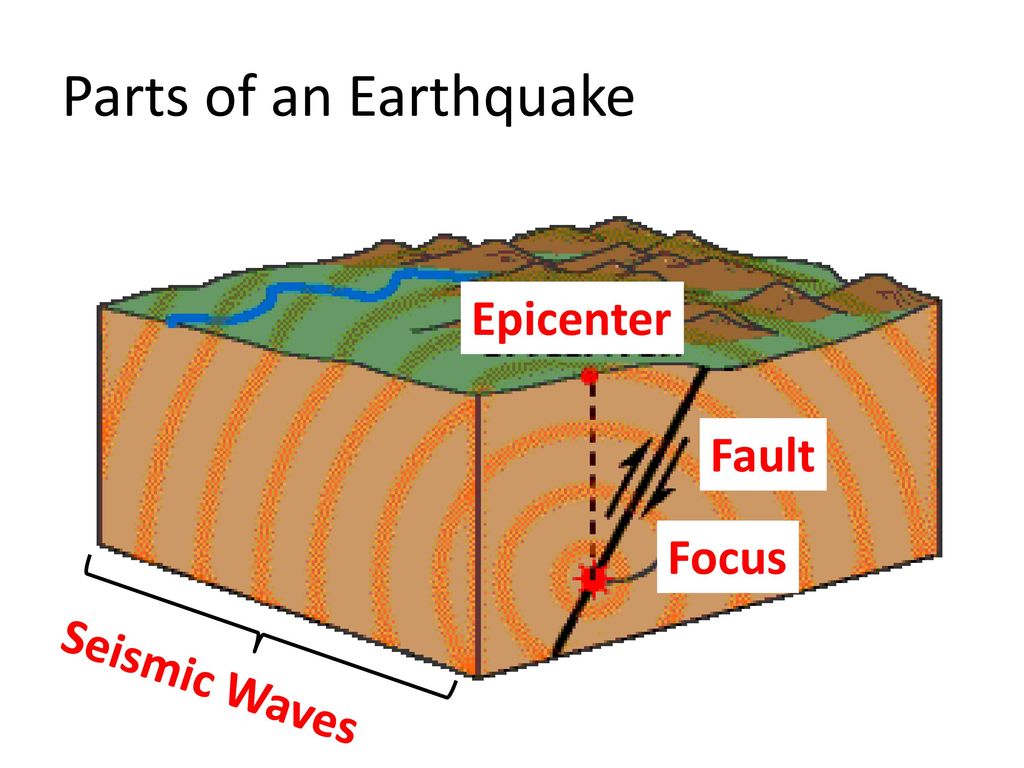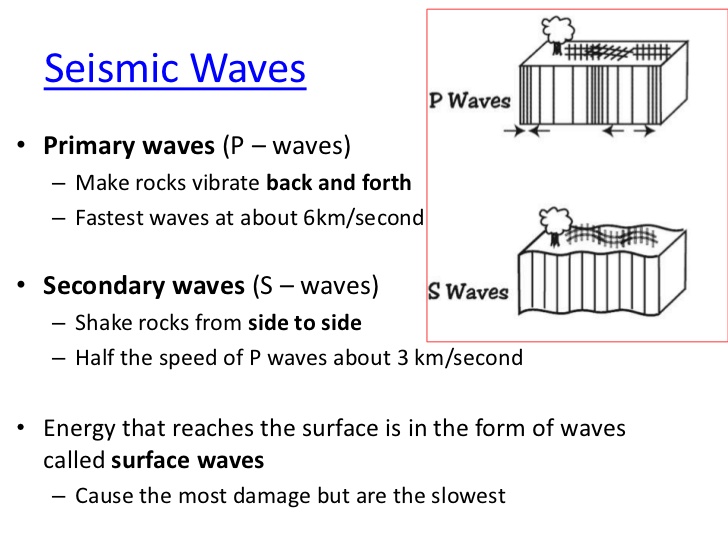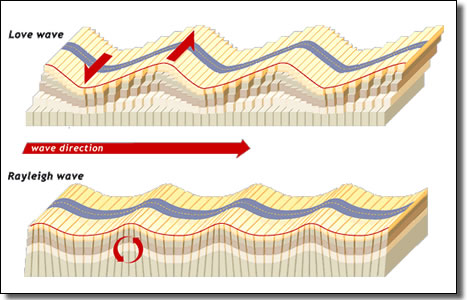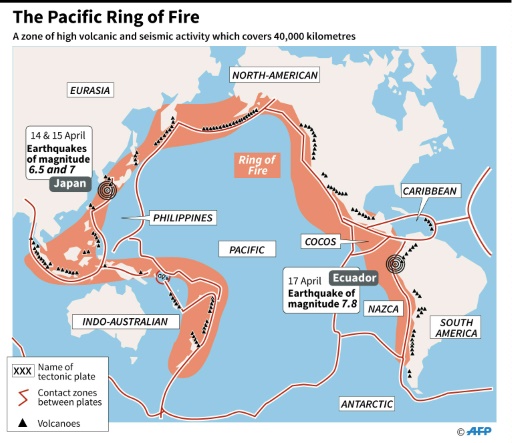↪ WHAT IS AN EARTHQUAKE? ↩
Earthquakes are caused by a sudden slip on a fault. The tectonic plates are always slowly moving, but they get stuck at their edges due to friction. When the stress on the edge overcomes the friction, there is an earthquake that releases energy in waves that travel through the earth's crust and cause the shaking that we feel. In addition, it can be caused by the sudden release of energy within some limited region of the rocks of the Earth. The energy can be released by elastic strain, gravity, chemical reactions, or even the motion of massive bodies, Earthquakes associated with this type of energy release are called tectonic earthquakes.
Earthquakes mostly occur along geologic fault lines, narrow zones where rock masses move in relation to one another. The major fault lines of the world are located at the fringes of the huge tectonic plates that make up Earth’s crust. In addition, most of the world’s earthquakes occur within the Pacific Ring of Fire (also known as Circum-Pacific Belt), a long horseshoe-shaped belt of earthquake epicentres, volcanoes, and tectonic plate boundaries fringing the Pacific Basin.
There are four principal types of elastic waves: primary and secondary, travel within Earth, whereas the other two, Rayleigh and Love waves, or known as surface waves, travel along its surface. In addition, seismic waves can be produced artificially by explosions.
Magnitude is a measure of the amplitude (height) of the seismic waves an earthquake’s source produces as recorded by seismographs. Seismologist Charles F. Richter created an earthquake magnitude scale using the logarithm of the largest seismic wave’s amplitude to base 10. Richter’s scale was originally for measuring the magnitude of earthquakes from magnitudes 3 to 7, limiting its usefulness. Today the moment of magnitude scale, a closer measurement of an earthquake’s total energy release is preferred.
DID YOU KNOW? The world's largest earthquake with an instrumentally documented magnitude occurred on May 22, 1960 near Valdivia, in southern Chile. It was assigned a magnitude of 9.5 by the United States Geological Survey. It is referred to as the "Great Chilean Earthquake" and the "1960 Valdivia Earthquake."
HOW CAN WE MITIGATE AN EARTHQUAKE?
We cannot prevent natural earthquakes from occurring but we can significantly mitigate their effects by identifying hazards, building safer structures, and providing education on earthquake safety and preparing for natural earthquakes we can also reduce the risk from human induced earthquakes.
Substantial seismological work was done to understand the characteristics of the soil motions reported in earthquakes. Such awareness is important in future earthquakes in order to develop earthquake-resistant structures. Although seismic effects such as ground slides, tsunami and fires cause death and devastation, most losses—both of life and property—related to the collapse of human-made structures in the violent earthquake. In engineering terms, designing and constructing structures that can withstand strong ground movements is the most efficient way of minimizing earthquake damage.
Make an Emergency Plan: Create a family emergency communications plan that has an out-of-state contact. Plan where to meet if you get separated. Make a supply kit that includes enough food and water for several days, a flashlight and a whistle. Don’t forget to include your pet in your emergency plan. Remember that some evacuation shelters do not accept pets. Click here to know how to make an emergency plan
Build an emergency kit with the supplies you will need if you have to quickly evacuate your home. Gather supplies, including non-perishable foods, cleaning supplies, and water for several days, in case you must leave immediately. It is recommended that there is at least 3 days’ worth of supplies on hand, including one gallon per day for each person and pet. Click here to know how to make an emergency kit
PRACTICE DROP, COVER, AND HOLD

In most situations when an earthquake occurs, wherever you are, drop down to your hands and knees then hold onto something sturdy (e.g. table, chairs.) If you’re using a wheelchair or a walker with a seat, make sure your wheels are locked (these locks are located on the top side frame rail in front of each rear wheel.) and remain seated until the shaking stops.

Immediately cover your head and neck with your arms. If there is a sturdy table or desk nearby, crawl underneath it for shelter. If no shelter is nearby, crawl next to an interior wall (away from windows.) Crawl only if you can reach better cover without going through an area with more debris.

Stay on your knees or bent over to protect your vital organs. If you are under a table or desk, hold on with one hand and be ready to move with it if it moves. If seated and unable to drop to the floor, bend forward, cover your head with your arms and hold on to your neck with both hands.
WHAT DO I NEED TO DO TO SURVIVE AN EARTHQUAKE?
Talk about earthquakes with your family so that everyone knows what to do in case of an earthquake. Discussing ahead of time helps reduce fear, particularly for younger children
Check at your workplace and your children's schools and day care centers to learn about their earthquake emergency plans.
Pick safe places in each room of your home, workplace and/or school. A safe place could be under a piece of furniture or against an interior wall away from windows, bookcases or tall furniture that could fall on you. Practice DROP, COVER and HOLD ON in each safe place.
Do not hang heavy items, such as pictures and mirrors, near beds, couches and anywhere people sleep or sit.
Learn how to shut off the gas valves in your home and keep a wrench handy for that purpose.
Install strong latches or bolts on cabinets. Large or heavy items should be closest to the floor.
Have a professional make sure your home is securely anchored to its foundation, as well as strengthening tips for exterior features, such as porches, decks, sliding glass doors, canopies, carports and garage doors.
DROP, COVER and HOLD ON! Move as little as possible - most injuries during earthquakes occur because of people moving around, falling and suffering sprains, fractures and head injuries.
If you are in bed, stay there, curl up and hold on, and cover your head.
Stay indoors until the shaking stops and you are sure it is safe to exit.
If you must leave a building after the shaking stops, use stairs rather than an elevator in case of aftershocks, power outages or other damage.
Be aware that smoke alarms and sprinkler systems frequently go off in buildings during an earthquake, even if there is no fire.
If you smell gas, get out of the house and move as far away as possible.
Before you leave any building check to make sure that there is no debris from the building that could fall on you.
Staying Safe outdoors
Try to get as far away from buildings, power lines, trees, and streetlights as possible.
Find a clear spot and drop to the ground. Stay there until the shaking stops.
If you're in a vehicle, pull over to a clear location and stop. Avoid bridges, overpasses and power lines if possible.
Stay inside with your seatbelt fastened until the shaking stops.
After the shaking has stopped, drive on carefully, avoiding bridges and ramps that may have been damaged.
If a power line falls on your vehicle, do not get out. Wait for assistance.
Be alert for falling rocks and other debris as well as landslides, If you are in a mountainous area or near unstable slopes or cliffs.
Expect aftershocks to follow the main shock of an earthquake. Be ready to Drop, Cover, and Hold On if you feel an aftershock
If you are in a damaged building, go outside and calmly move away from the building. Do not enter other damaged buildings
If away from home, return only when authorities say it is safe to do so.
Check yourself for injuries and get first aid, if necessary, before helping injured or trapped persons.
After an earthquake, the disaster may continue. Expect and prepare for potential aftershocks, landslides or even a tsunami if you live on a coast. Aftershocks frequently occur minutes, days, weeks and even months following an earthquake.
Look for and extinguish small fires. Fire is the most common hazard after an earthquake.
Watch out for fallen power lines or broken gas lines and report them to the utility company immediately.
If you smell natural or propane gas or hear a hissing noise, leave immediately and call the fire department.
Listen to a portable, batteryoperated or handcrank radio for updated emergency information and instructions.
EMERGENCY HOTLINES
911
Truck Lines :
911-506162636465
Operations Center :
(02) 8911-1406
(02) 8912-2665
(02) 8912-5668
(02) 8911-1873
Truck lines :
(02) 8931-8101 to 07
Disaster Response Unit :
(02) 8856-3665
(02) 8852-8081
Text Hotline :
0918-912-2813
Hotline :
143
Disaster Management Office :
132 (Manager)
133 (Radio Room)
134 (Staff)
Emergency Hotline :
117
(02) 8722-0650
Text Hotline :
0917-847-5757
Direct Line :
(02) 8426-0219
(02) 8426-0246
REFERENCES & ADDITIONAL INFORMATION
Earthquake | Definition, Causes, Effects, & Facts. (2020). Retrieved 10 October 2020, from https://www.britannica.com/science/earthquake-geology
Earthquakes | Ready.gov (2020) Retrieved 11 October 2020, from https://www.ready.gov/earthquakes
Usgs.gov. (2013). What is an earthquake and what causes them to happen? [online] Available at: https://www.usgs.gov/faqs/what-earthquake-and-what-causes-them-happen?qt-news_science_products=0# [Accessed Oct. 2020].
Usgs.gov. (2016). Can we cause earthquakes? Is there any way to prevent earthquakes? [online] Available at: https://www.usgs.gov/faqs/can-we-cause-earthquakes-there-any-way-prevent-earthquakes?qt-news_science_products=0#qt-news_science_products [Accessed Oct. 2020].
Geology.com. (2011). Largest Earthquake Recorded - World’s Biggest Earthquake. [online] Available at: https://geology.com/records/largest-earthquake/ [Accessed Oct. 2020].
Anon, (2021). Stay Safe During an Earthquake. [online] Available at: https://www.cdc.gov/disasters/earthquakes/during.html [Accessed Oct. 2020].
Earthquake - Methods of reducing earthquake hazards | Britannica. (2021). In: Encyclopædia Britannica. [online] Available at: https://www.britannica.com/science/earthquake-geology/Methods-of-reducing-earthquake-hazards [Accessed Oct. 2020].




